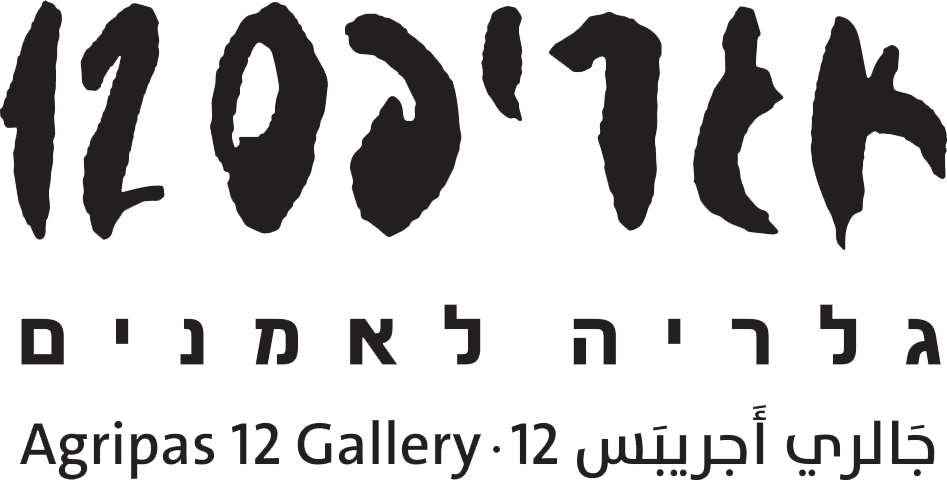
מעשה במרחב, תערוכה קבוצתית משותפת בגלריות אגריפס 12 ומרי
אוצרת: נאוה ט׳ בראזני
פתיחה: 15.9.2022 | נעילה: 19.11.2022
משתתפים: דורון אדר | ג׳ודית אניס | מקס אפשטיין | הדסה בארי | יעל בוברמן-אטאס | רוני ברות | אלחנדרו גולדברג | מירי גרמיזו |
לנה זידל | עודד זידל | מאיר ראובן זלבסקי | נעמי טנהאוזר | גבי יאיר | אריאן ליטמן | נחום מלצר | ריטה מנדס-פלור | שרה נינה מרידור |
בן סימון | רינה עזרוני | רינה פלד | אביגיל פריד | נטשה קוזנצובה | חנה קרומר | אורי ראושר | בתיה רוזנק | רות שרייבר
SPATIAL ACTION, joint group exhibition, in the galleries Agripas 12 and Marie
Curator: Dr. Nava T. Barazani
opening: 15.9.2022 | closing: 15.9.2022
Artists: Judith Anis | Roni Baroth | Hadassah Berry | Yael Boverman-Attas | Chana Cromer | Doron Adar | Max Epstein | Rina Ezroni | Avigail Fried | Miri Garmizo
Alejandro Goldberg | Natasha Kuznetsova | Ariane Littman | Rita Mendes-Flohr | Nahum Meltzer | Sarah Nina Meridor | Rina Peled | Uri Rauscher
Bitya Rosenak | Ruth Schreiber | Ben Simon | Nomi Tannhauser | Gabi Yair | Lena Zaidel | Oded Zaidel | Meir Reuven Zalevsky
English text after Hebrew
מעשה במרחב
עבודת אמנות היא – בין השאר – תוצאה של מערכת יחסים בין אמן לבין מרחב עבודה. מעשה במרחב היא עלילה המתרקמת מתוך המקומות בהם שוהים, משתהים ופועלים אמנים החברים בשתי זירות אמנות בירושלים: גלריה אגריפס 12 וגלריה מרי. הסטודיו, החלל הביתי, המרחבים החיצוניים או הזיקות שבין הפנים לבין החוץ, גם בין הפיזי לבין הנפשי, הם חוטי המארג השזורים בין המעברים השונים כדי לספר סיפור חזותי-עכשווי על מרחבי עבודה ועל מעשים.
ואמנם, ״האמנות משמרת ומשתמרת בפני עצמה״(1) ומחוות האמנות אינן תלויות עוד ביוצר שקבע וטבע אותן. אף נוסיף ונאמר שיצירת האמנות, ״תרכובת של נתפסים ומורגשים […]״,(2) ״ישות טהורה של תחושה״,(3) עומדת וקיימת בכוחות עצמה. נוכל להמשיך ולגעת ב׳מות המחבר׳, המוחק את היחס הברור שבין המסמן למסומן.(4) אולם נתמקד כעת במתודה המחפשת והחוקרת, המשתנה מיוצר ליוצר ומאמן לאמן, המתגלגל, מתפלש ומתהווה עם העולם החולף. כך מעשה במרחב מתייחסת אל החילוץ של אותם רגעים שהאמנים מבחינים בהם מתוך העולם ומתוך החיים ומוסיפים להם ממדים ׳טהורים של תחושות׳.
לצורך כך נדון בראייה כמחווה על העולם ובגוף המגלם את המעשה במרחב. היכולת לראות היא היכולת להיות בתוך העולם. מוריס מרלו פונטי מחדד את ההכרח בפתיחות חזותית אל הנראה כדי שתתקיים מעורבות בעולם. כלומר שמעבר לעין המביטה החוצה אל השדה החזותי מתקיים חיבור בין העין לבין תנועת הגוף האנושי, כזה המפיח חיים בהצטלבות מחודשת ובחידת הקשר בין הדברים. במילים אחרות, הגוף מהווה מרקם של ראייה ושל תנועה הממשיכה אותו כפרי בשל של ממשות ושל פעולה. העולם אינו מהווה ייצוג חיצוני מול האמן אלא שהוא עצמו נולד ואחוז בתוך הדברים עצמם והם מהווים חלק מהגדרתו. כך עבודת האמנות, פרי מעשיו של האמן המסייר בגופו הנוכח בעולם, מאפשרת קיום גם למה שבראיית חולין נדמה בלתי נראה.(5)
מאז תחילת שנות השישים התרחשה אבולוציה בהגדרת הסטודיו של האמן בתגובה לשינויים תרבותיים, חברתיים, פוליטיים ומתוך הקשרים ביקורתיים. מאז ששוליו של חלל הסטודיו הופקעו באופן דקונסטרוקטיבי, נתפס הסטודיו הסגור והמבודד של האמן אנכרוניסטי ושריד מהתקופה הרומנטית. אולם, אף שפעולת האמן בחלל הסטודיו כאקט פולחני התרוקנה ממשמעות, הסטודיו כמושג לא נעלם. גם בעידן הפוסט-פוסט סטודיו האמנים לא פסקו ליצור בין כתליו והוא משמש לא פעם מרחב מתווך והיברידי עבור הניסיונות הרדיקליים, ליצור את החיבור בין האמנות לבין החברה בהקשרים משתנים ומתעצבים משעה לשעה. התפיסה העכשווית של הסטודיו האידיאלי של האמן היא היותו מרחב משתנה המאפשר עבודה במרחבים רבים ושונים, הן הממשיים והן הווירטואליים ובמסגרות זמן שונות. הסטודיו, בהקשרים העכשוויים, הוא מודל טרנס-דיסציפלינארי של התבוננות אל העולם הגדול שבחוץ ושיתוף פעולה עמו. בין אם בחדר מבודד או באמצעות פעולות במקומות ציבוריים כגון בית קפה, פארק או רכבת ואף בנדודים או בפעולות בו-זמניות בכמה מקומות או במספר יבשות.(6)
מישל דה סרטו כותב שכל סיפור הוא סיפור מסע ושסיפורי המרחב שלנו מארגנים את המקומות, קושרים ביניהם ויוצרים מסלולים תלויי הקשרים.(7) הוא מקביל את הסיפור לזיכרון ולניסיון להבין אירוע מסוים ולדובב את עקבות העבר כדי להחיות אותן בהווה. ברי מכאן שהדיווח אינו מדויק, שכן סיפור המסע מצוי בתנועת תמיד ורווי הקשרים. דה סרטו, ששולל עקבות קבועים או גבולות מוכתבים המדלדלים את המצאת היומיום,(8) מבקש אחר מסלולים ומעשים שיסמנו את המרחב וינועו בו כ״עצים של מחוות״(9). בהשאלה, עבודות התערוכה מרחיבות את המצאת היומיום, מספרות סיפורים על מעשים במרחב ומסמנות מסלולים ניידים ותלויי הקשרים המצטלבים זה בזה, לעיתים.
1. ז׳יל דלז ופליקס גואטרי, מהי פילוסופיה?, תל אביב: רסלינג, 2008 , עמ׳ 181.
2 שם, עמ׳ 182.
3 שם, עמ׳ 185.
4 רולאן בארת, מות המחבר, תל אביב: רסלינג, 2005.
5 מוריס מרלו-פונטי, העין והרוח, תל אביב: רסלינג, 2004, עמ׳ 66-29.
6 ראו למשל: , Rachel Esner, Sandra Kisters, Ann-Sophie Lehmann (eds.), Hiding Making Showing Creation
The Studio from Turner to Tacita Dean, Amsterdam: Amsterdam University Press, 2013; Wouter Davidts
.and Kim Paice, The Fall of The Studio: Artists at Work, Amsterdam: Netherlands, 2009
7 מישל דה סרטו, המצאת היומיום, תל אביב: רסלינג, 2012, עמ׳ 244-243 , 253.
8 שם, עמ׳ 217-216.
9 דה סרטו מצטט את רילקה. שם, עמ׳ 223.
אוצרת: נאוה ט׳ בראזני
פתיחה חגיגית חמישי 15.9.2022
התערוכה תהיה מוצגת מיום שלישי, 13.8.22 – עם פתיחת פסטיבל מנופים
Spatial Action
The work of art is the outcome, among others, of a relationship between an artist and a workspace. Spatial Action is the visual plot woven from the places in which the member artists of two art arenas in Jerusalem spend time and interact: the galleries Agripas 12 and Marie. The studio, domestic space, external spaces, or the links between interior and exterior, the physical and psychological, are the intertwining threads between spaces that form the fabric of the contemporary visual narrative of workspaces and actions.
And yet, “Art preserves, and is the only thing in the world that is preserved. It preserves and is preserved in itself…”(1) Postmodern thinkers attempted to sever the artist from the artwork and described the work of art as “a paradoxical monument which does not commemorate a past, but rather, preserves itself in the absence of man.”(2) According to this theory, the gestures of art are no longer dependent on the creative artist who determined and shaped it. We can also add that the work of art is “a ‘compound’ of ‘percepts’ and affects’,”(3) a “‘being’ of sensations,” standing independently, existing on its own.(4)
We can continue to touch upon the theory of the “death of the author” that nullifies the clear relationship between signifier and signified.(5) However, let us now focus on the methodology of search and research that changes with each artist as he or she transforms, processes, and makes something come into being. Spatial Action refers to the extraction of those very same moments in which artists distinguish elements from the world and from life, adding to them “a pure bloc of sensations.”
To this end, we shall discuss seeing as gesturing towards the world emanating from the body and embodying the action in space. According to Maurice Merleau-Ponty, the ability to see is the capacity to be in the world. This makes the necessity for visual openness even more acute in order to create involvement in the world. Beyond the eye looking outward to the field of vision, there is a connection between the eye and the movement of the human body. This movement breathes life into renewed intersections and into the enigmatic link between things. In other words, the body constitutes “an intertwining of vision and movement” which makes a transition into concreteness and action like the ripening of a fruit coming into maturity. The world is not an external representation which artists see, but the artists themselves are born into the world, and therefore are part of and intertwined with the elements defining the world.(6) Thus, the artwork, made by the artist who moves bodily through the texture of the world, enables the existence of what seems invisible through “profane viewing.”(7)
Since the early 1960s, a revolution has taken place in the definition of the artist’s studio, in response to sociocultural and political changes, as well as shifting critical contexts. Since the margins of the studio space have been expropriated and deconstructed, the closed, isolated artist’s studio has been perceived as anachronism, a remnant of romanticism. However, despite the emptying out of meaning from the artist’s actions in the studio as a ritual act, the studio as a concept has not disappeared. In the postmodern era, artists’ studios have not ceased production, often acting as mediating, hybrid spaces for radical experiments attempting to forge connections between art and society in a constantly changing reality. The contemporary perception of the ideal artist’s studio is that it is a changing space enabling work in many different spaces, both concrete and virtual, in varying time frames. It is seen as a transdisciplinary model of observation of, and working with, the external world. The artist may work in an isolated room or perform actions in public spaces such as cafés, parks, or trains, wandering through the city, or through actions performed simultaneously in several locations or on several continents.(8)
Michel de Certeau wrote that every narrative is a spatial story – the story of a journey – and that our spatial narratives organize places, link them, and create routes and context-specific performances.(9) He draws a parallel between “story” and “memory” and the attempt to understand a specific event, to make the marks of the past speak and be revived into the present. The reporting is not precise, since the narrative of the journey depends on the context, and is in constant movement. De Certeau, who negates permanent traces or predetermined borders that dilute the practices of everyday life,(10) searches for routes and actions to mark the space as “trees of gestures”(11) in movement.
1 Gilles Deleuze and Félix Guattari, What is Philosophy? (1991), Eng. ed., H. Tomlinson and G. Burchell, trans. (New York: Columbia Univ. Press, 1994), p. 163.
2 Ibid.
3 Ibid.
4 Ibid.
5 Roland Barthes, Death of the Author (1967).
6 Maurice Merleau-Ponty, Eye and Mind (1964).
7 Ibid.
8 For example, Rachel Esner, Sandra Kisters, Ann-Sophie Lehmann (eds.), Hiding Making Showing Creation, The Studio from Turner to Tacita Dean, Amsterdam: Amsterdam University Press, 2013; Wouter Davidts and Kim Paice, The Fall of The Studio: Artists at Work, Amsterdam: Netherlands, 2009.
9 Michel de Certeau, The Practice of Everyday Life (1984). English ed. Berkeley and Los Angeles: University of California, (1984).
10 Ibid.
11 Rilke quoted by De Certeau, p. 102.
Curator: Dr. Nava T. Barazani
Opening Reception: Thursday 15.9.22
The exhibition will be on view from Tuesday, 13/8/22
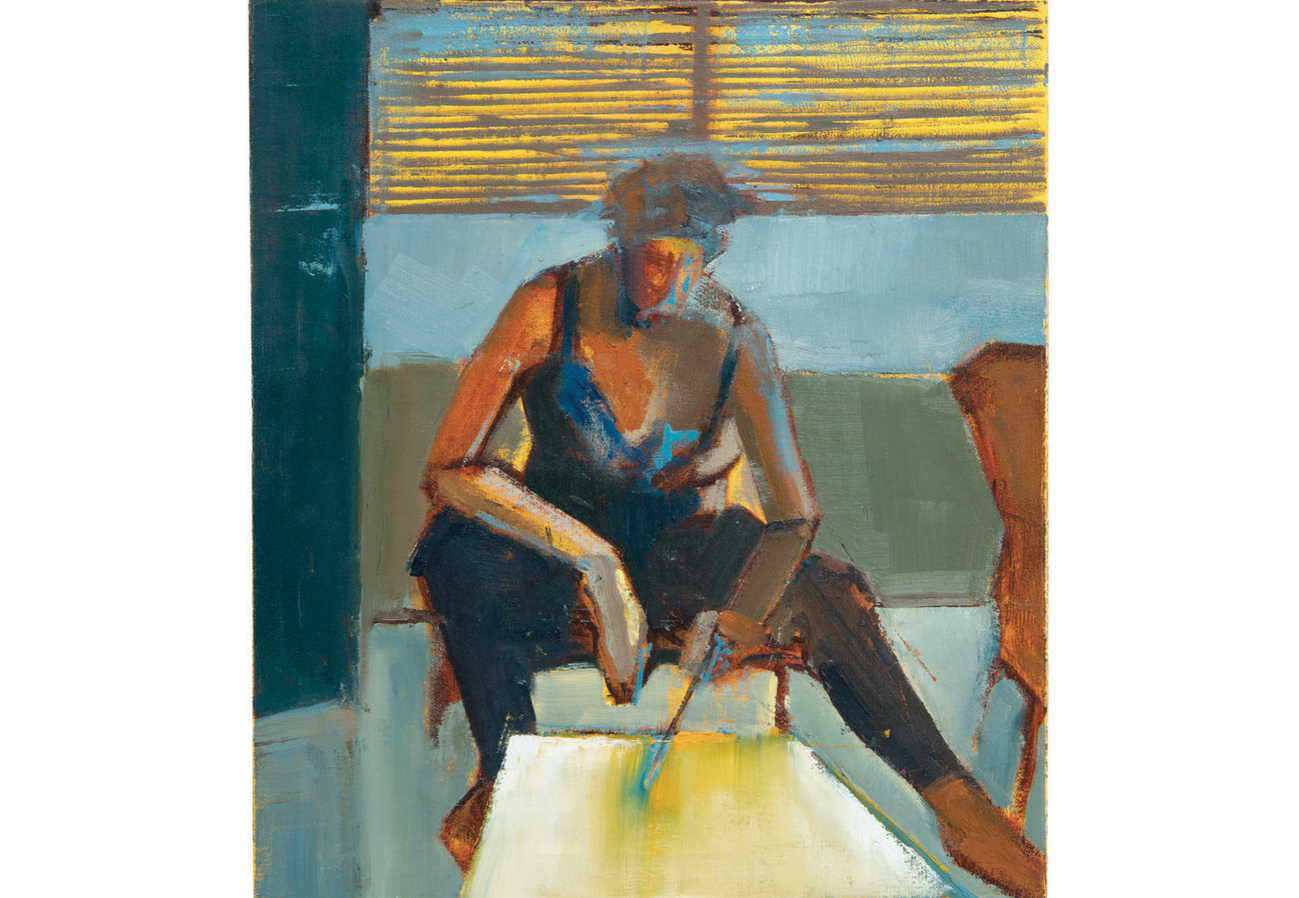

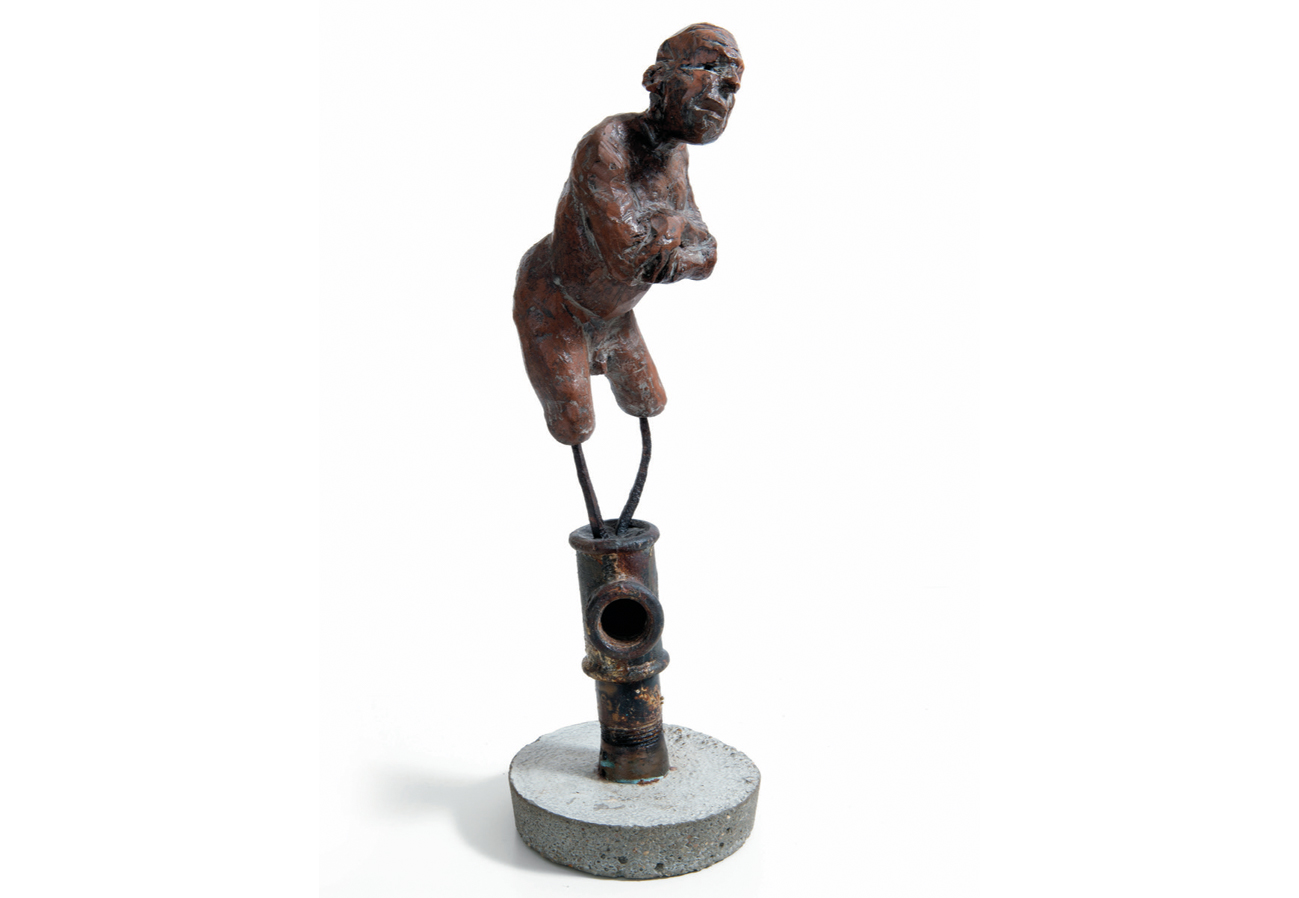

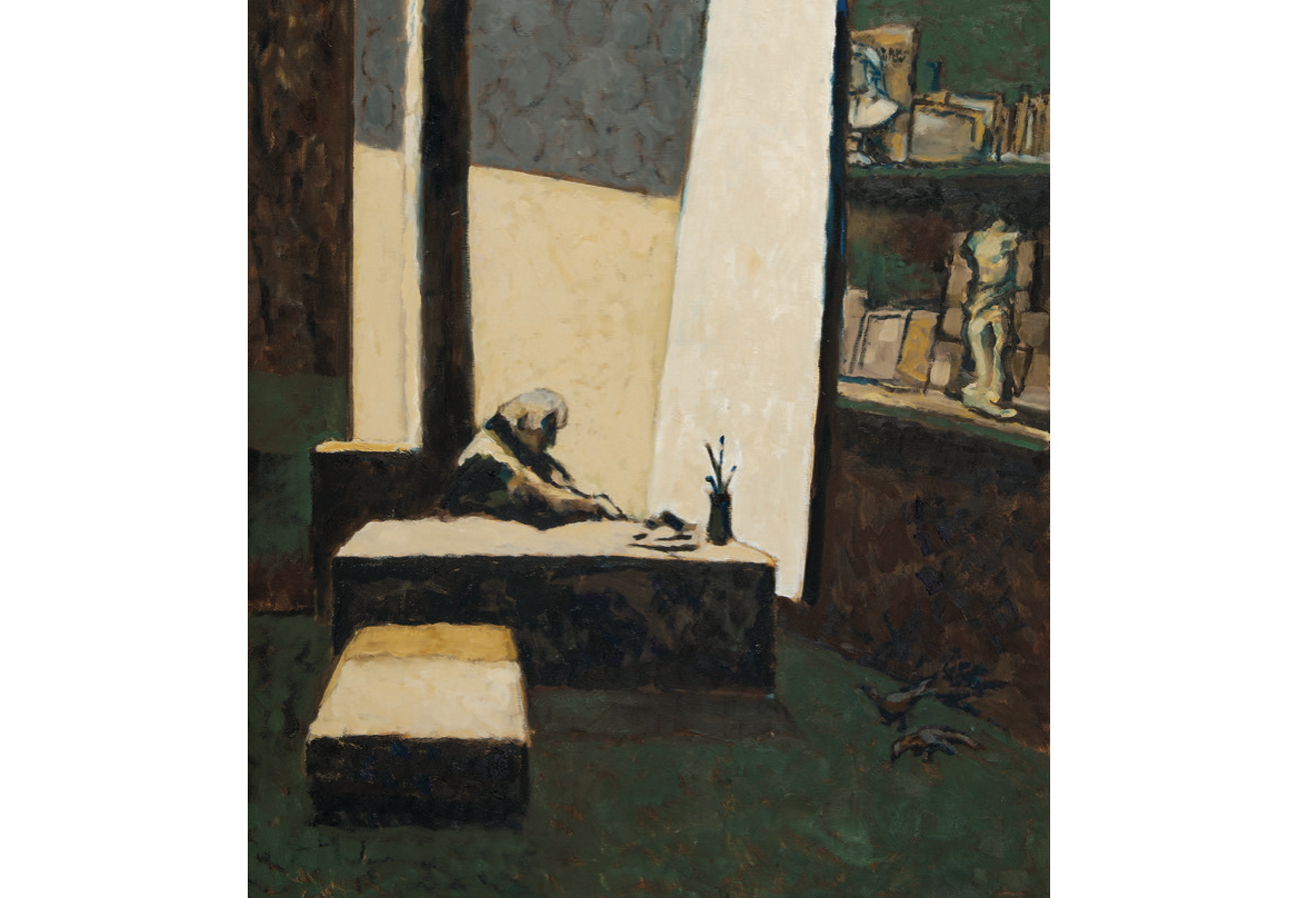


מקס אפשטיין, חלון (מתוך הסידרה "פחם"), 2012 , הדפסה דיגיטלית על מראה, חלון מצוי שרוף, 40×100
Max Epstein, Window (from "Coal" series), 2012, Digital print on mirror
found burned window, 40×100
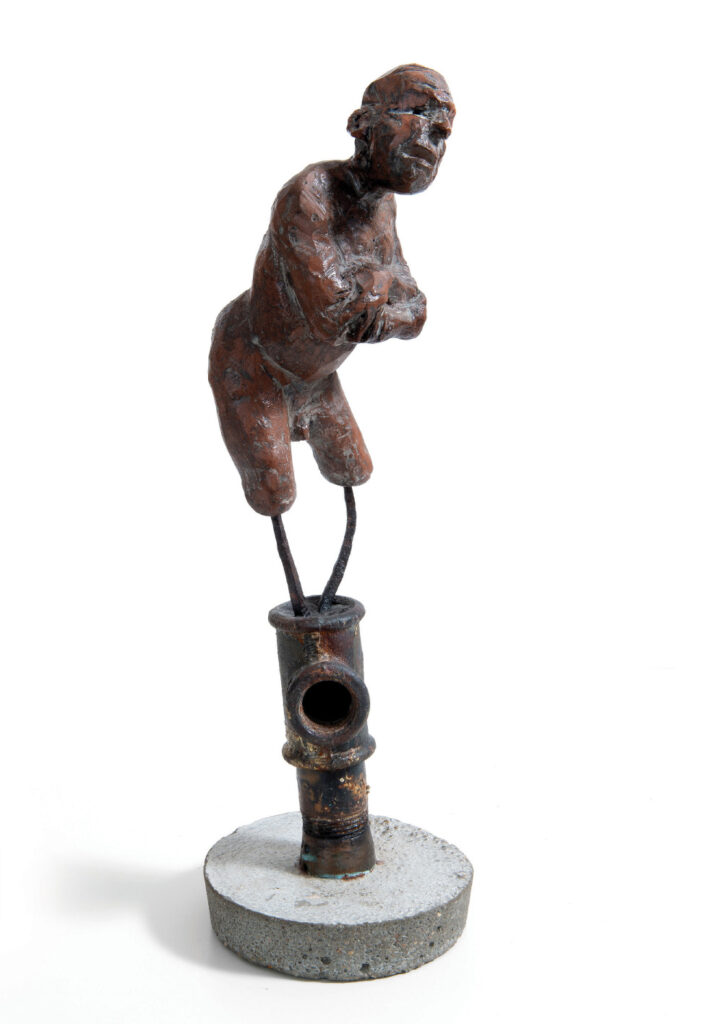
מקס אפשטיין, מנקה ארובות, 2021 , טכניקה מעורבת, 35×10
Max Epstein, Chimney Sweeper, 2021, Mixed technique, 35×10

אריאן ליטמן, ירושלים – קווי מחלוקת, 2022, מפה, בד, חבישות גאזה, גבס ודיו, 154×110
מבוסס על מפת כבישים של ירושלים, 1:10,000, פרייטג וברנדט ) 2019) ומפות של ירושלים מהאתר של שאול אריאלי
Ariane Littman, Jerusalem – Lines of Contention, 2022, Maps, fabric, gauze bandages, plaster and ink, 154×110ת Based on the city street map of Jerusalem (1:10,000) by Freytag & Berndt (2019) and on the maps of Jerusalem by Shaul Arieli

רינה פלד, אתר בניה, 2019 , שמן על לוח עץ, 50×70
Rina Peled, Building Site, 2019, Oil on wood, 50×70
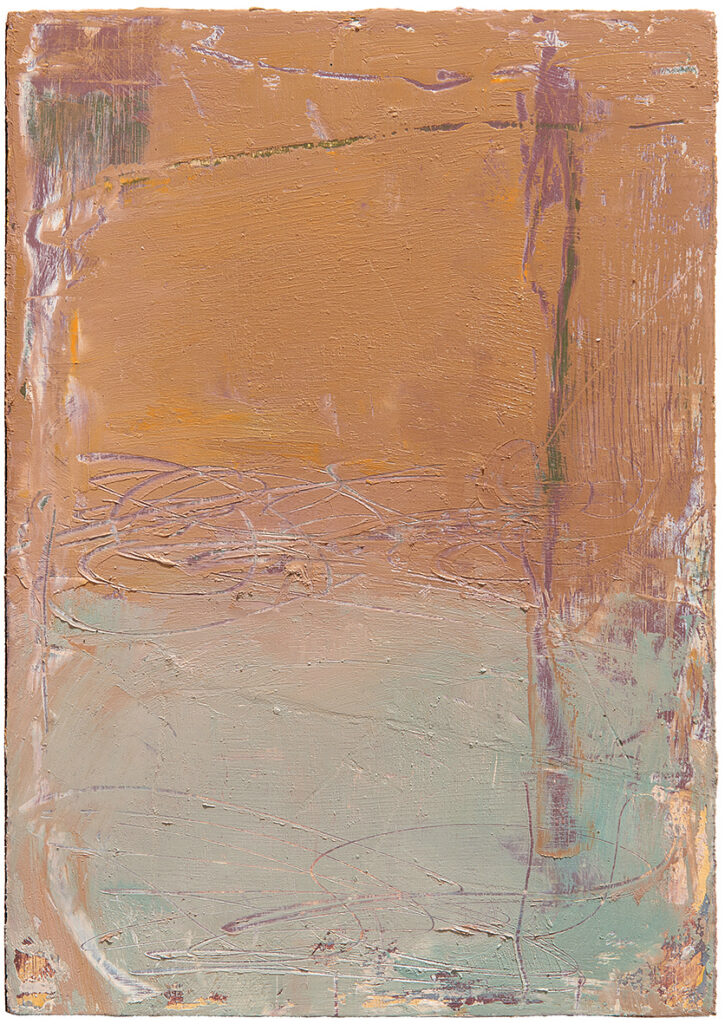
רינה פלד, ציור קיר, 2022 , שמן על לוח עץ, 21×15
Rina Peled, Wall Painting, 2022, Oil on wood, 21×15
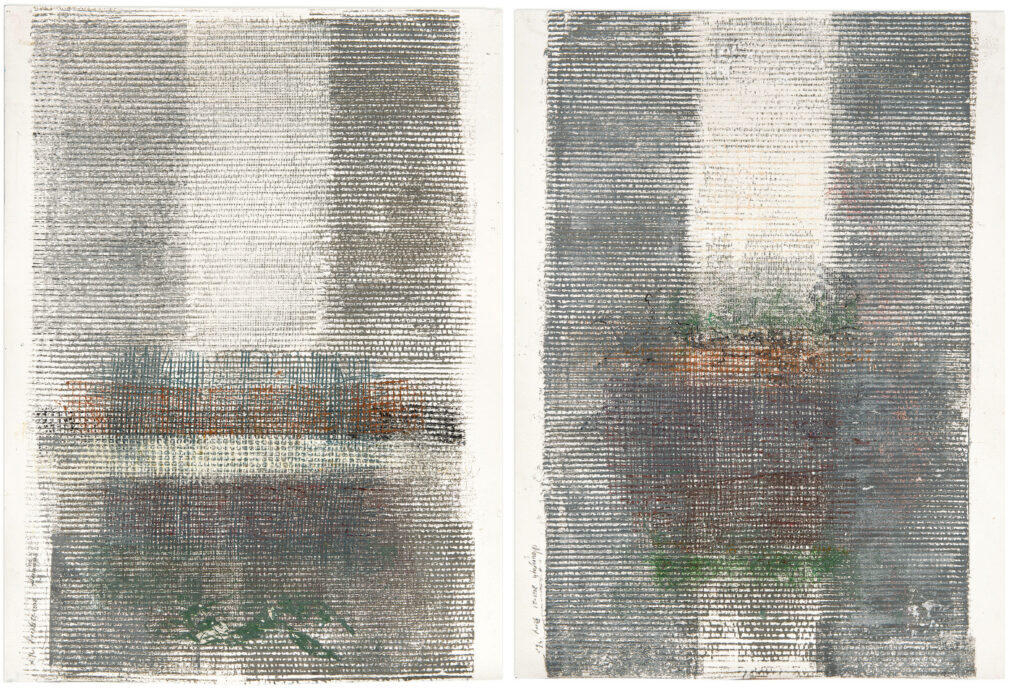
הדסה בארי, בנייה בסרט נע, 2022 , קולרגרף, 74×88
Hadassah Berry, Building After Building, 2022, Collagraph, 74×88
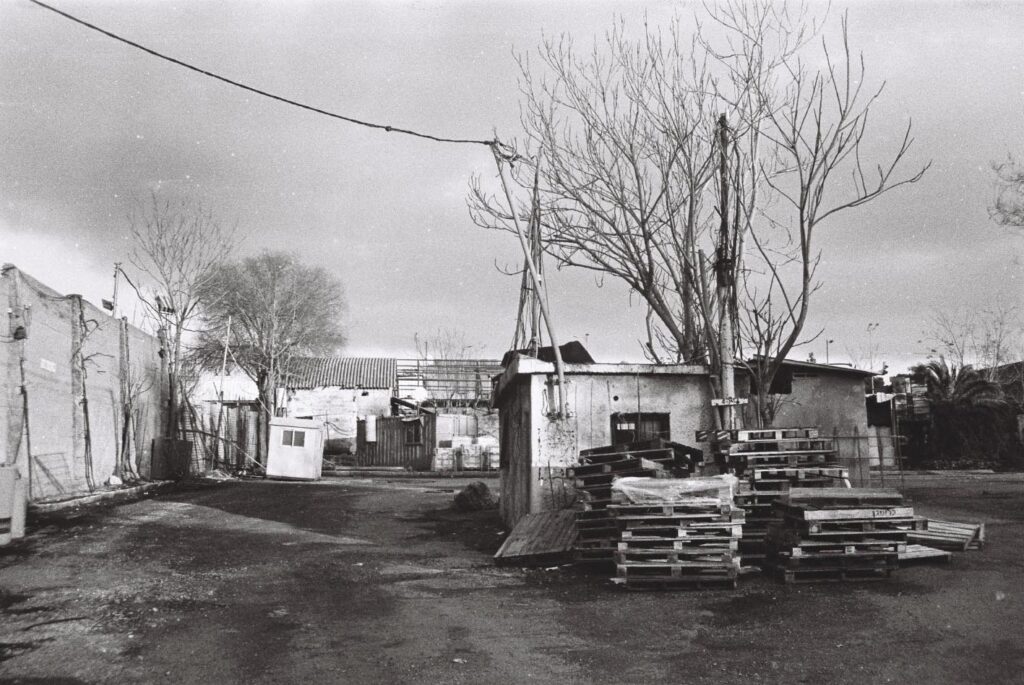
מאיר ראובן זלבסקי, תפילה לשלום (2), 2021 , הדפסה על נייר ארכיבי, 30×40
Meir Reuven Zalevsky, Prayer for Peace (2), 2021, Print on archival paper, 30×40
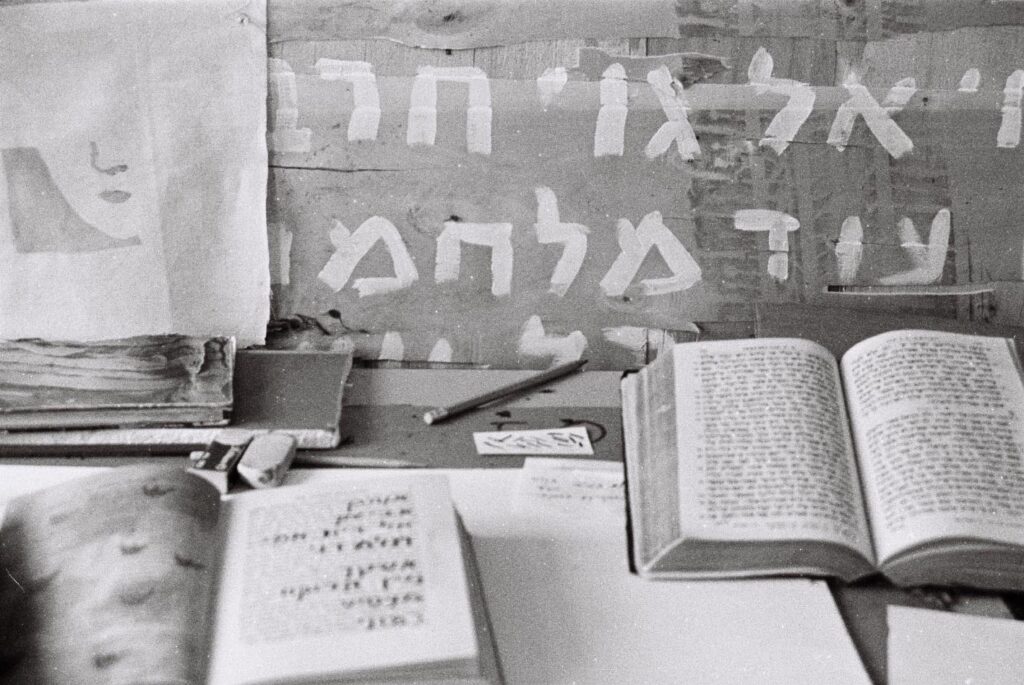
מאיר ראובן זלבסקי, תפילה לשלום (1), 2021 , הדפסה על נייר ארכיבי, 30×40
Meir Reuven Zalevsky, Prayer for Peace (1), 2021, Print on archival paper, 30×40
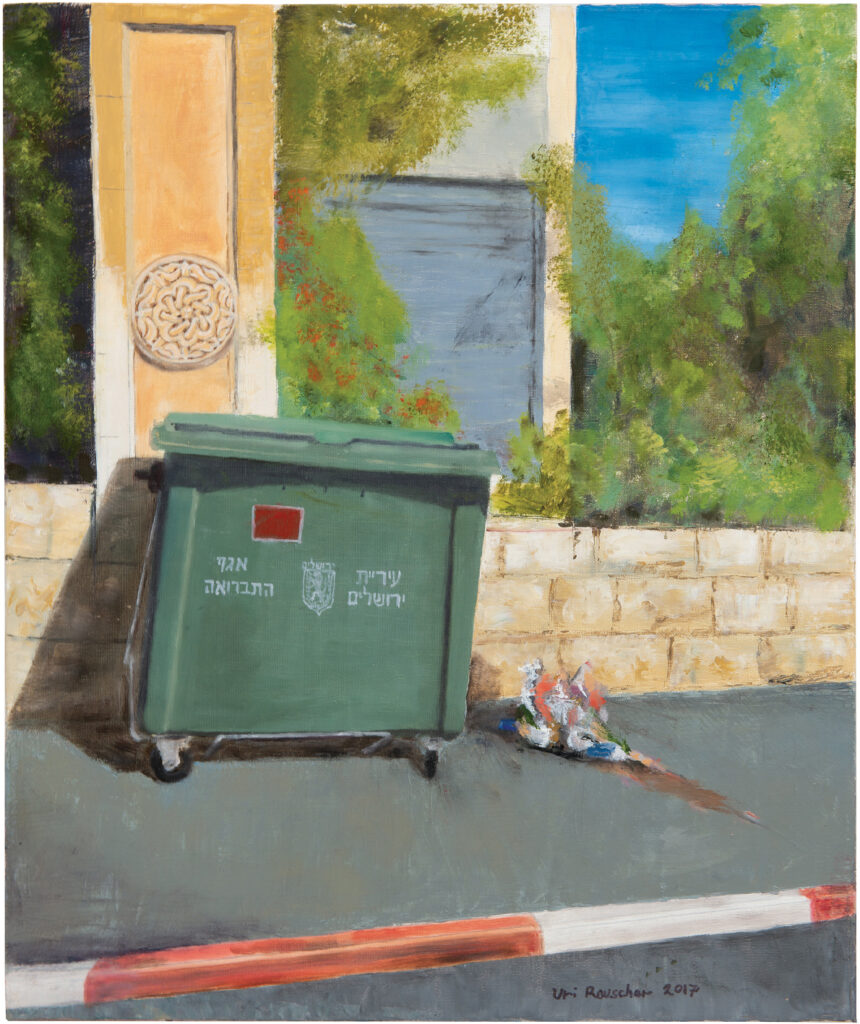
אורי ראושר, זיווג מטעם עיריית ירושלים, 2021 , שמן על קנווס, 50×50
Uri Rauscher, A Match Created by Our Municipality, 2021, Oil on canvas, 50×50
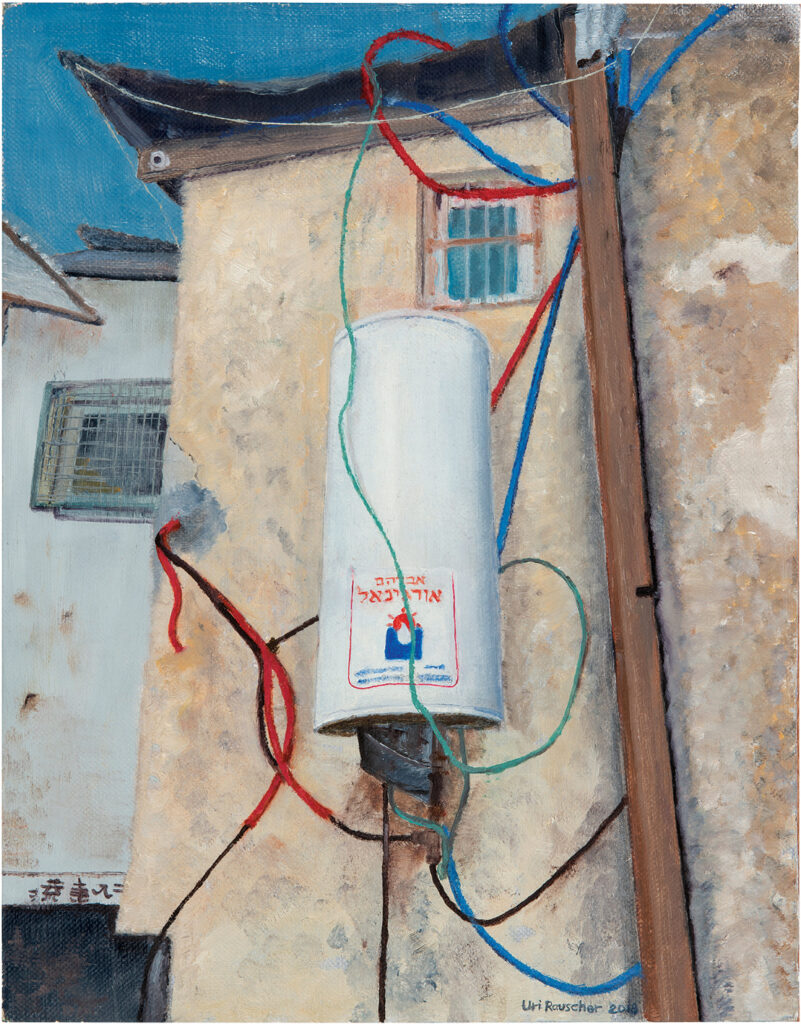
אורי ראושר, אצלנו בחצר, 2018 , שמן על עץ, 45×35
Uri Rauscher, In Our Yard, 2018, Oil on plywood, 45×35

ריטה מנדס-פלור, ניווט שמימי, 2022 , צילום, 60×80
Rita Mendes-Flohr, Celestial Navigation, 2022, Photography, 60×80

בתיה רוזנק, רחימו, 2022 , שמן ופיגמנט על נייר, 50×35
Bitya Rosenak, Rehimu, 2022, Oil and pigments on paper, 50×35
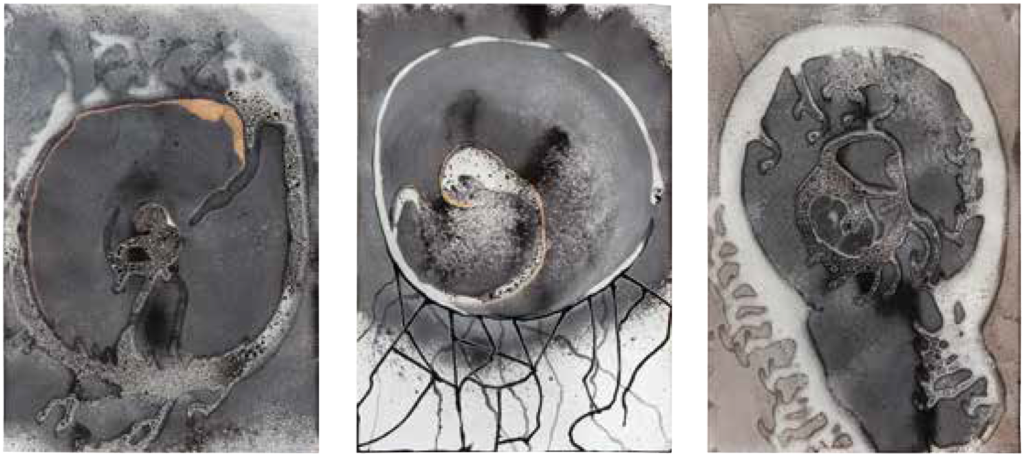
בתיה רוזנק, רחימו, 2022 , שמן ופיגמנט על נייר
Bitya Rosenak, Rehimu, 2022, Oil and pigments on paper

ג׳ודית אניס, בעקבות רודן 5, 2022 , הדפס על נייר, 35×25
Judith Anis, After Rodin V, 2022, Print on paper, 35×25

ג׳ודית אניס, בעקבות רודן 8, 2022 , שבלונת נייר, 35×25
Judith Anis, After Rodin VIII, 2022, paper Stencil, 35×25
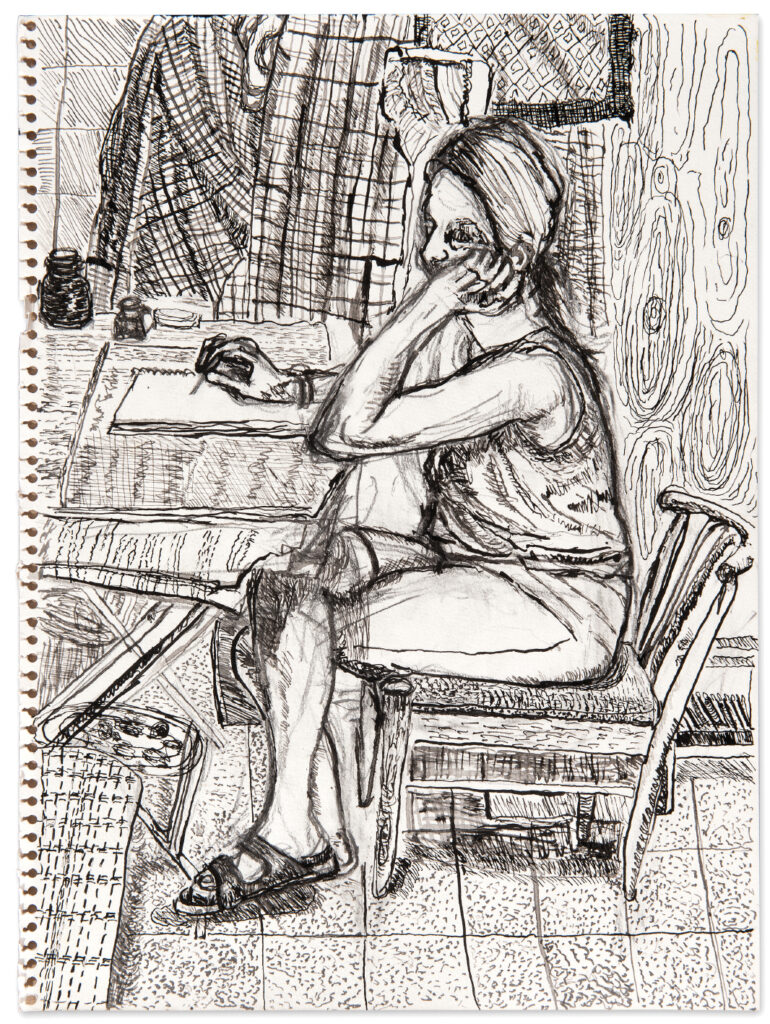
רינה עזרוני, נדודי שינה בבייג׳ין, 2006 , עיפרון על נייר סיני, 28×36
Rina Ezroni, Sleepless in Beijing, 2006, Pencil on chinese paper, 28×36

רינה עזרוני, דיוקן עצמי, 2008 , דיו על נייר סיני, 20×19
Rina Ezroni, Self Portrait, 2008, Ink on chinese paper, 20×19
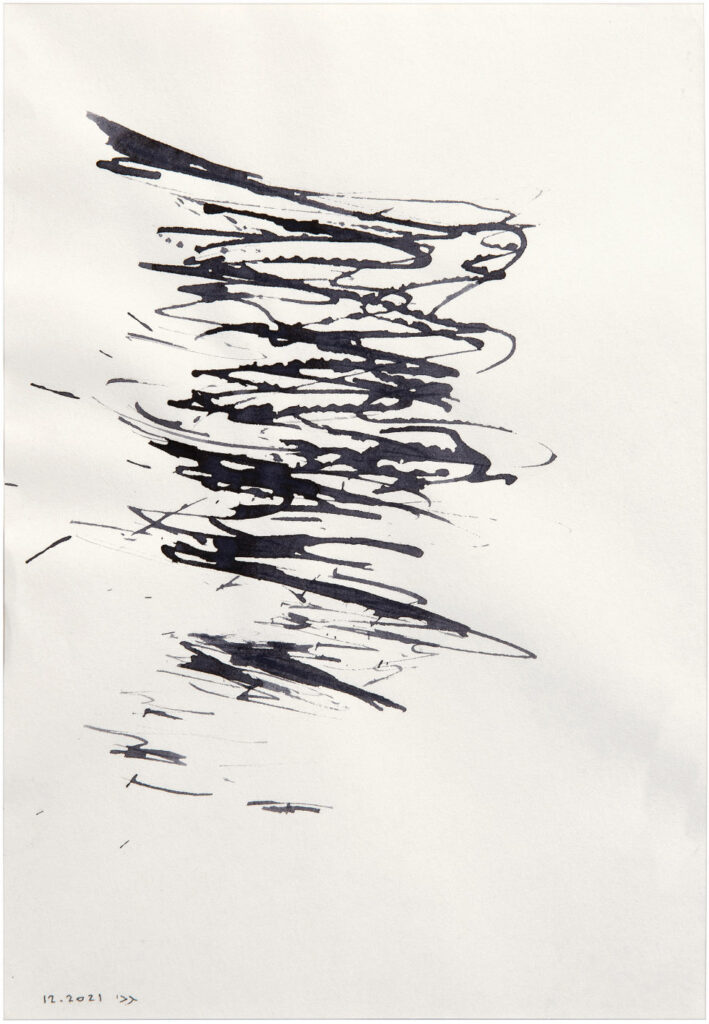
גבי יאיר, ללא כותרת, 2020, דיו על ניר, 30×20
Gabi Yair, Untitled, 2020, Ink on paper, 30×20
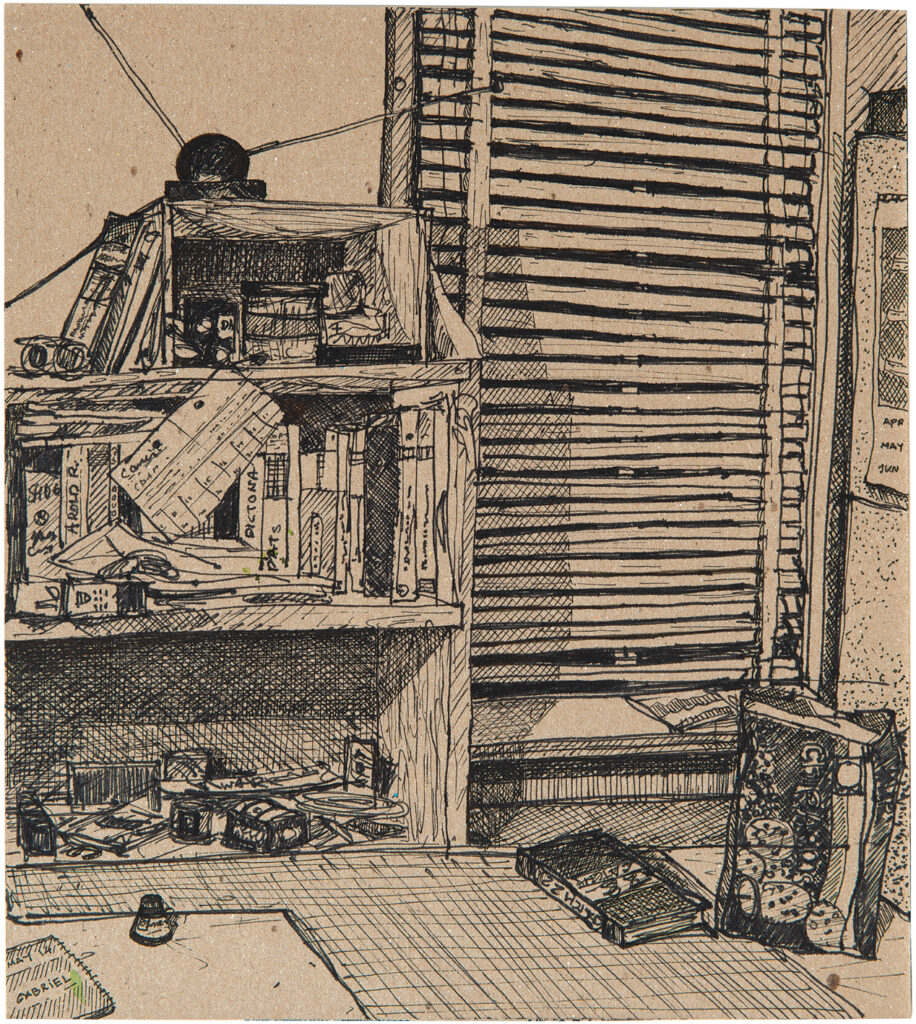
גבי יאיר, סטודיו בניו-יורק, 1980, דיו על קרטון, 23×20.5
Gabi Yair, Studio in N.Y.C, 1980, Ink on cardboard, 23×20.5

אלחנדרו גולדברג, ללא כותרת, 2022 , שמן על פשתן, 220×70
Alejandro Goldberg, Untitled, 2022, Oil on linen, 220×70
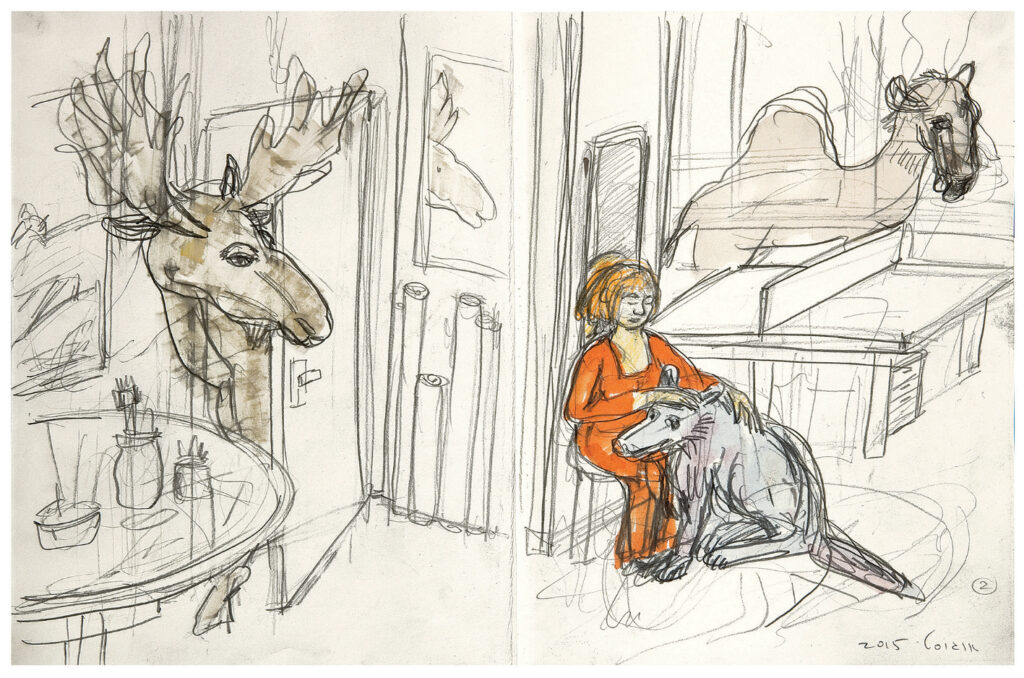
לנה זידל, לנה בסטודיו 1, 2015 , גרפיט וטוש צבעוני על נייר, 27×42
Lena Zaidel, Lena in the Studio 1, 2015, Graphite and colored marker on paper, 27×42

לנה זידל, לנה בסטודיו 4, 2015 , גרפיט וטוש צבעוני על נייר, 27×42
Lena Zaidel, Lena in the Studio 4, 2015, Graphite and colored marker on paper, 27×42
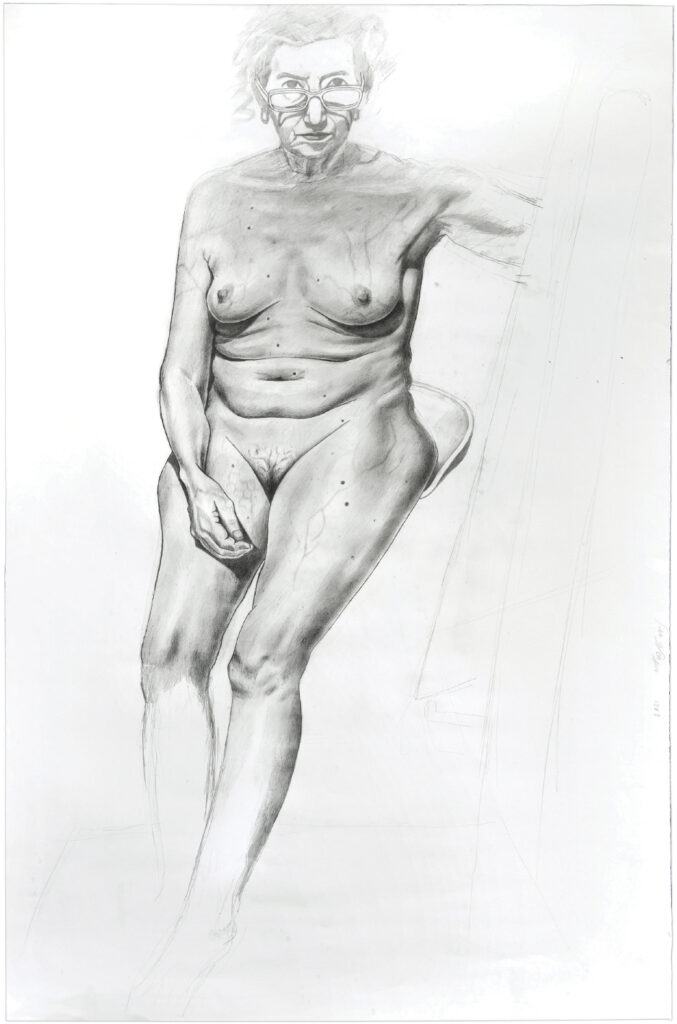
נעמי טנהאוזר, התבוננות נוקבת, 2021 , עפרון על נייר, 100×65
Nomi Tannhauser, Profound Observation, 2021, Pencil on paper, 100×65

נעמי טנהאוזר, דיוקן עצמי עם מאוורר, 2017 , עפרון על נייר, 15.2×19.3
Nomi Tannhauser, Self Portrait with Fan, 2017, Pencil on paper, 15.2×19.3
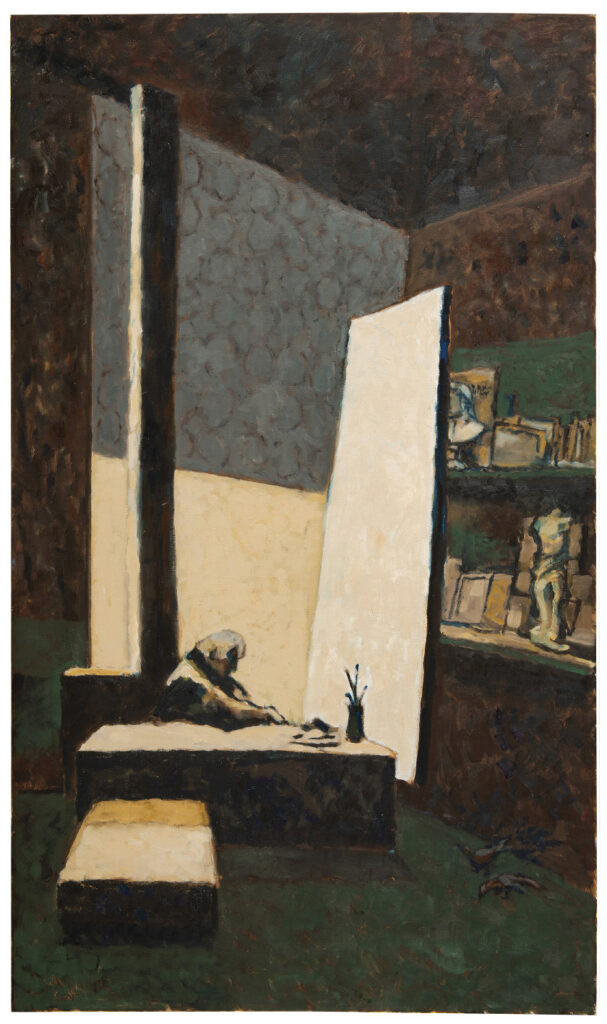
נחום מלצר, מול בד לבן, 2022 , צבע שמן על בד, 120×60
Nahum Meltzer, White Canvas, 2022, oil on canvas, 120×60
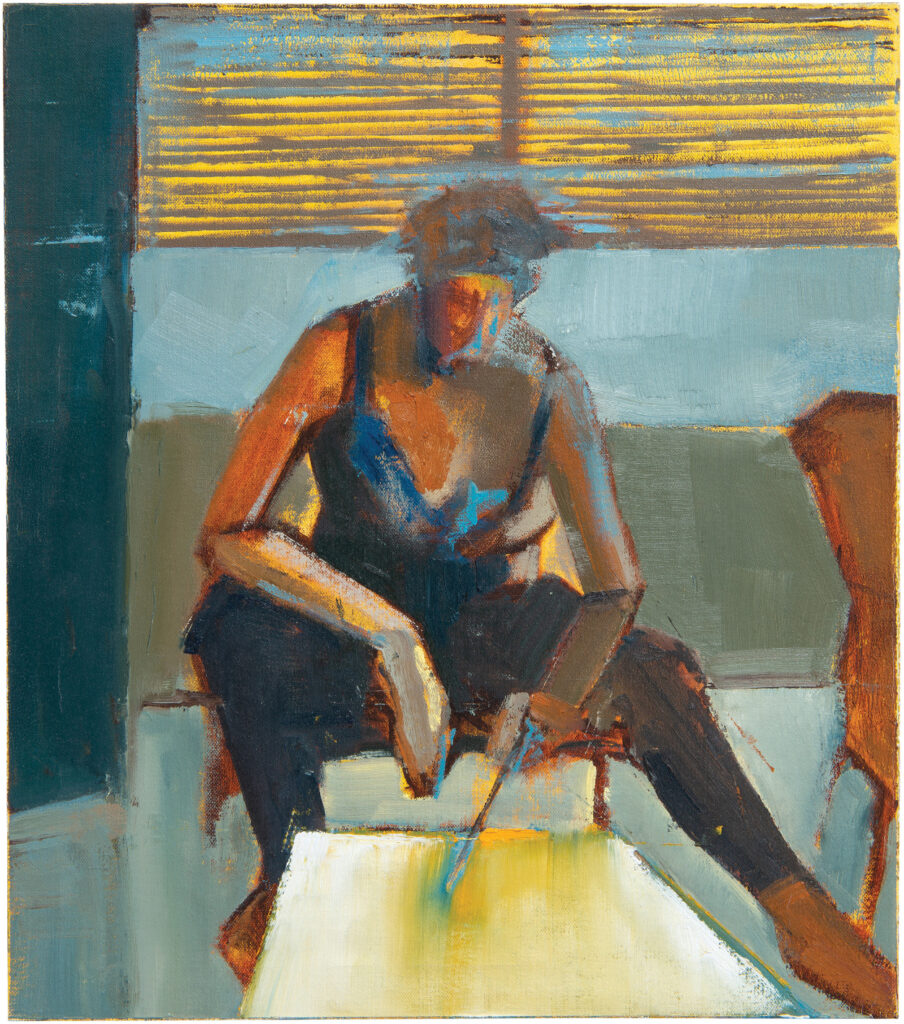
יעל בוברמן-אטאס, הבטחה, 2020 , שמן על בד, 40×35
Yael Boverman-Attas, Promise, 2020, Oil on canvas, 40×35

יעל בוברמן-אטאס, בסטודיו, 2022 , גרפיט על פאנל, 11×13
Yael Boverman-Attas, In the Studio, 2022, Graphite on panel, 11×13

עודד זידל, בסטודיו, 2022 , אקריליק על בד, 100×100
Oded Zaidel, In the Studio, 2022, Acrylic on canvas, 100×100

אביגיל פריד, שירבוט, 2021 , שמן על בד, 70×45
Avigail Fried, Scribble, 2021, Oil on canvas, 70×45

אביגיל פריד, שעת קריאה, 2022 , שמן על בד, 70×35
Avigail Fried, Reading Time, 2022, Oil on canvas, 70×35
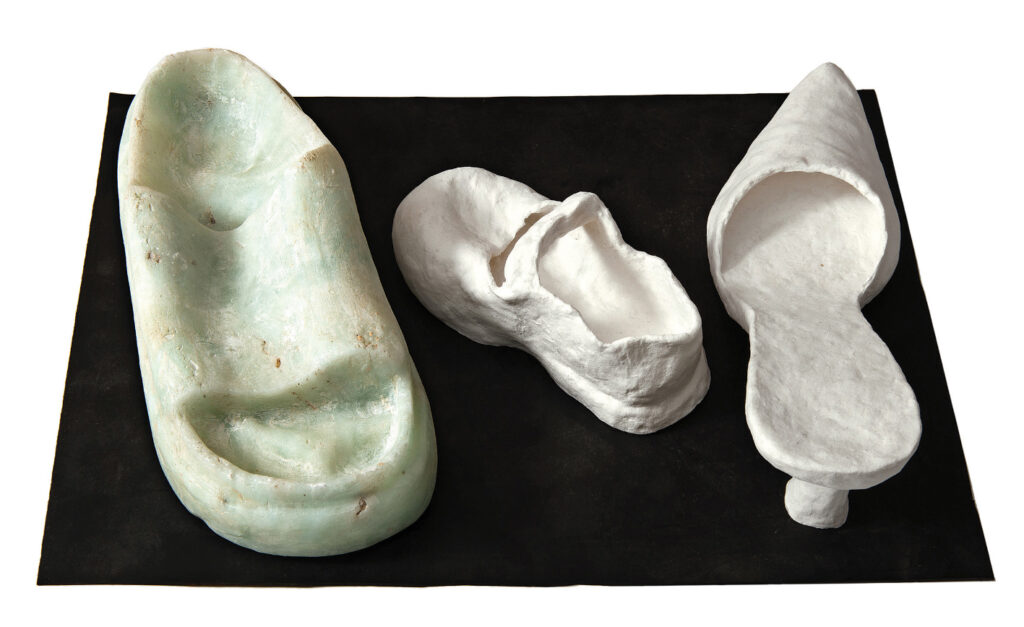
רות שרייבר, ריקוד החיים, 2010 , זכוכית נייר וגומי, 11x25x18
Ruth Schreiber, Dance of Life, 2010, Glass, paper, rubber, 11x25x18

רות שרייבר, חלומות ללא סיכוי, 2012 , מדיה מעורבת 30x50x3
Ruth Schreiber, Impossible Dreams, 2012, Mixed media, 30x50x3

נטשה קוזנצובה, מקומה של האישה ליד כן הציור, 2017 , אקריליק על קנבס, 140×85
Natasha Kuznetsova, Woman's Place at the Easel, 2017, Acrylic on canvas, 140×85
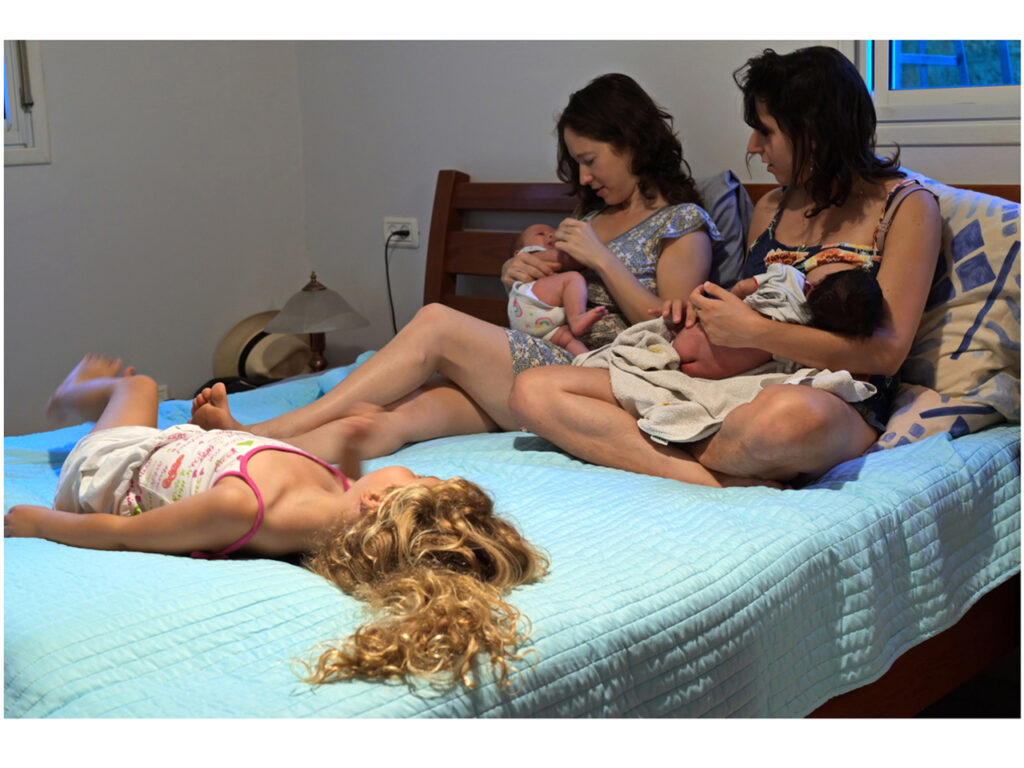
דורון אדר, זמן נשים, 2021, צילום, הדפסת הזרקת דיו
Doron Adar, Women Time, 2021, Photography, inkjet print
דורון אדר, חדר משפחה, 2021 , צילום, הדפסת הזרקת דיו, 21×14
Doron Adar, Family Room, 2021, Photography, inkjet print, 21×14

בן סיימון, ראש כחול מלוקק עם חתול, 2006 , שמן על דיקט, 74×51
Ben Simon, Blue Head Lick with a Cat, 2006, Oil on panel, 74×51
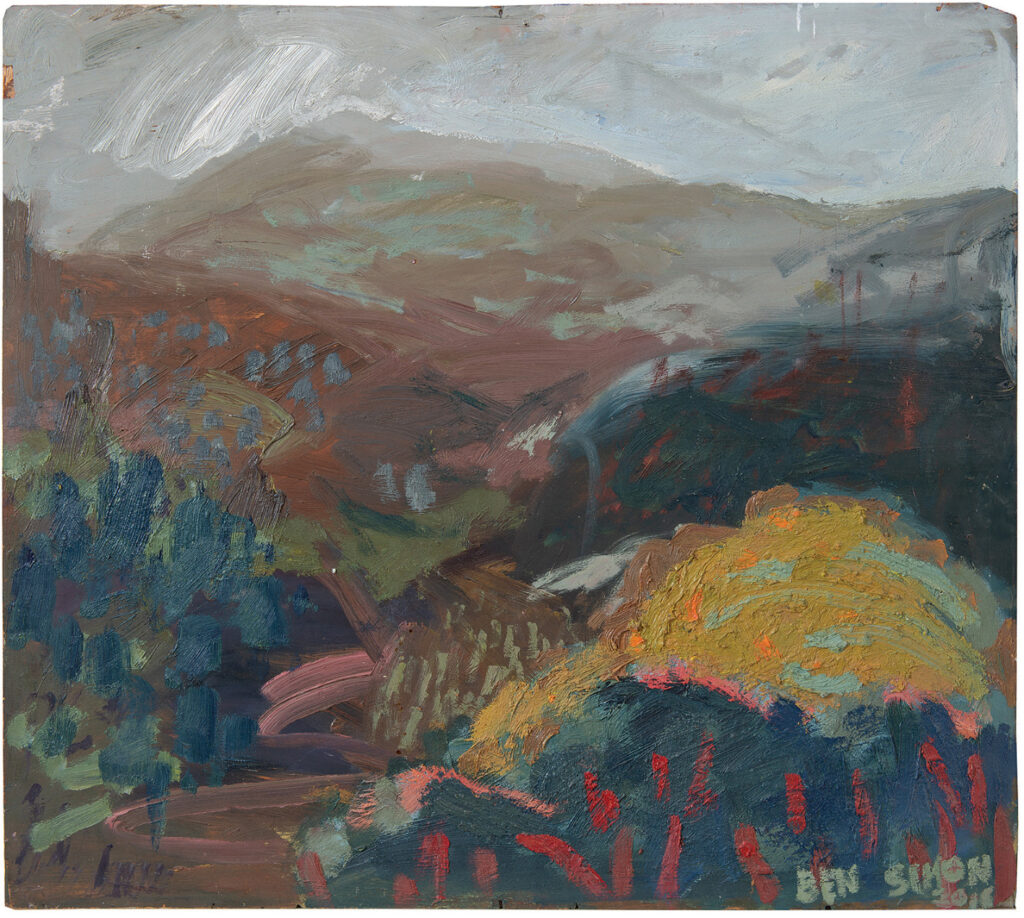
Ben Simon, Hilly Landscape, 2016, Oil on panel, 55×65
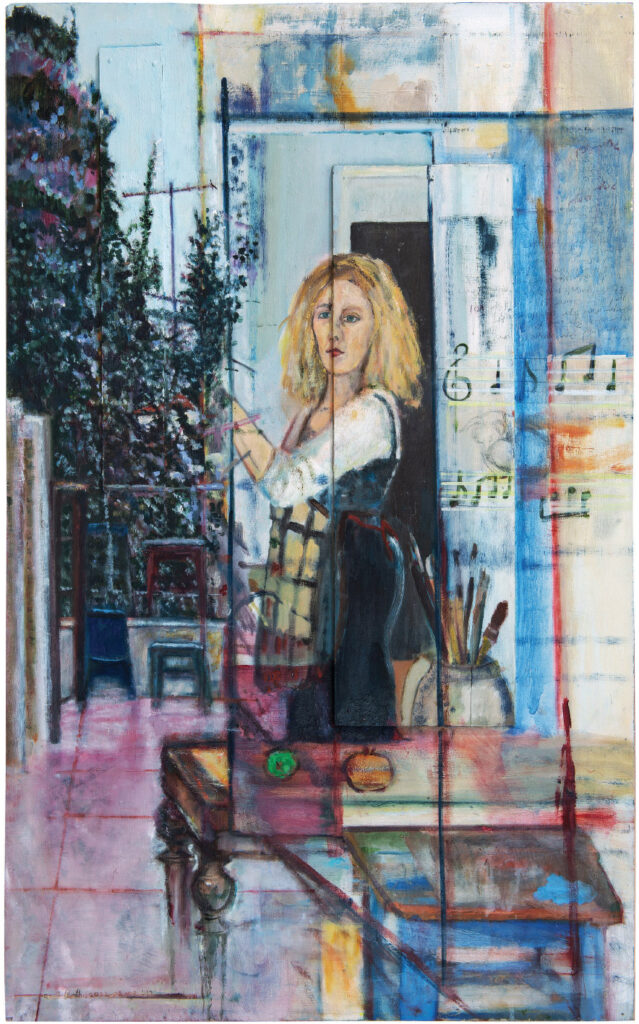
רוני ברות, דיוקן עצמי עם מרפסת, 2002-2022 , שמן על לוח עץ, 123×76
Roni Baroth, Self Portrait with a Balcony, 2002-2022, Oil on board, 123×76
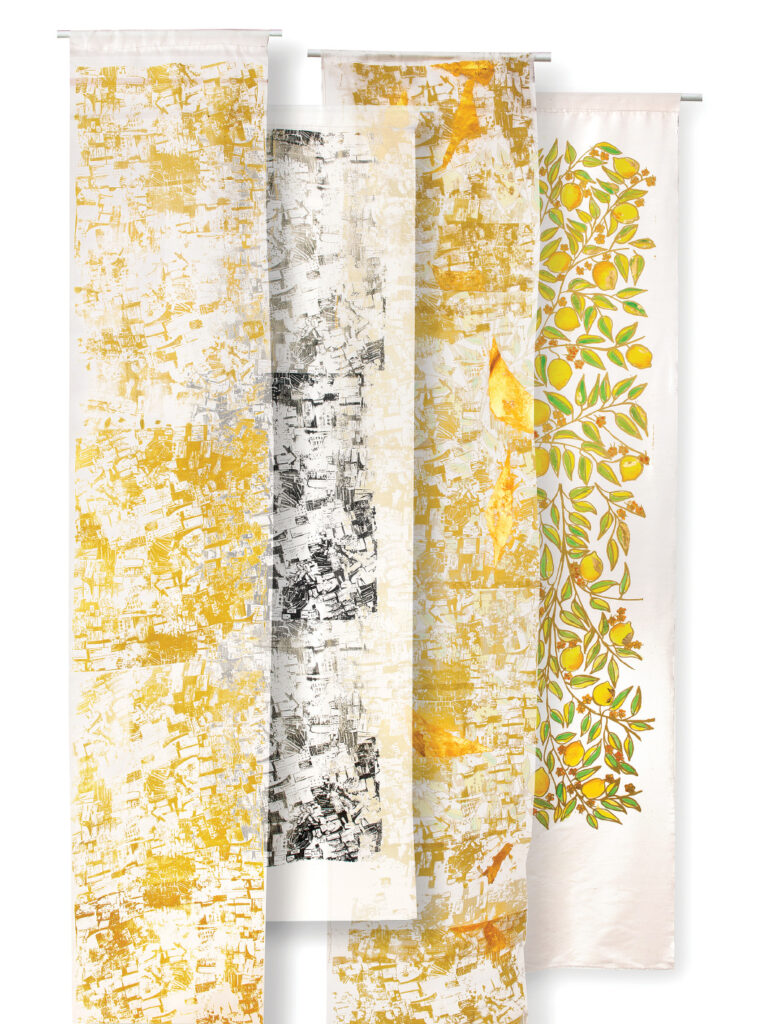
חנה קרומר, מים, מים (פרט), 2022, הדפסי רשת, צבעים מתכתיים,
שכבות משי אורגנזה ומשי שנטונג, ריקוע זהב, 280×60
Chana Cromer, Water, Water (detail), 2022, Multiple silk screens
metallic pigments, layers of silk organza and shantung, gold leaf, 280×60
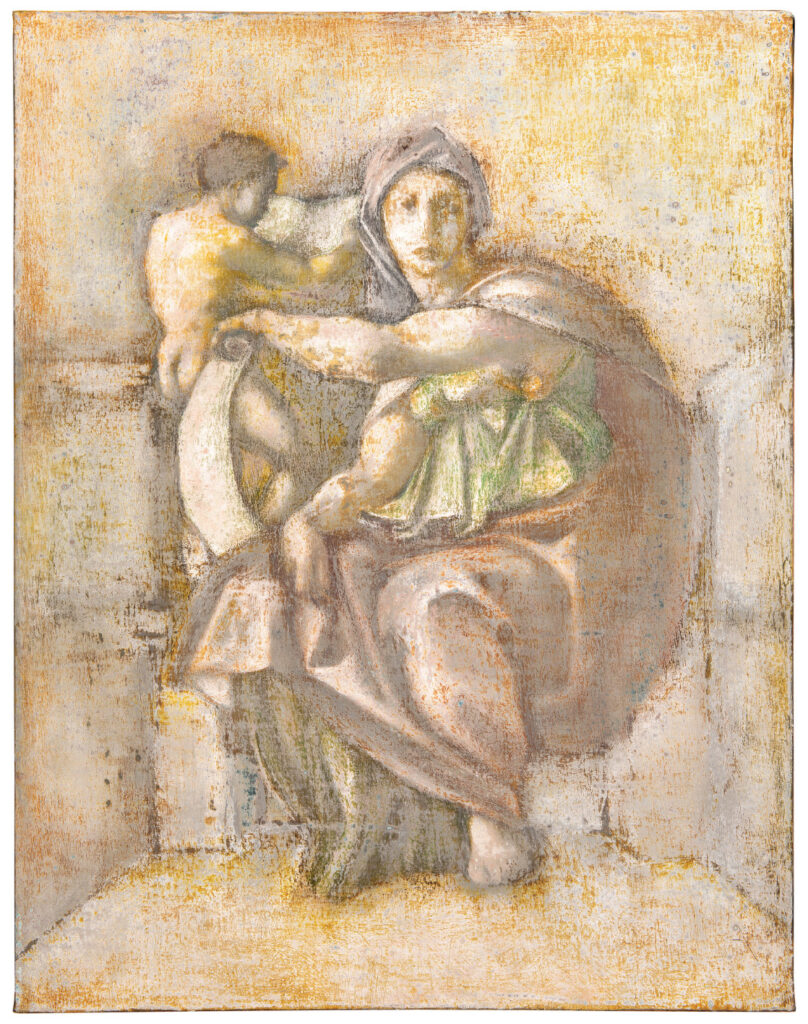
שרה נינה מרידור, נבואה, 2022 , שמן על בד, 72×95
Sarah Nina Meridor, Prophecy, 2022, Oil on canvas, 72×95
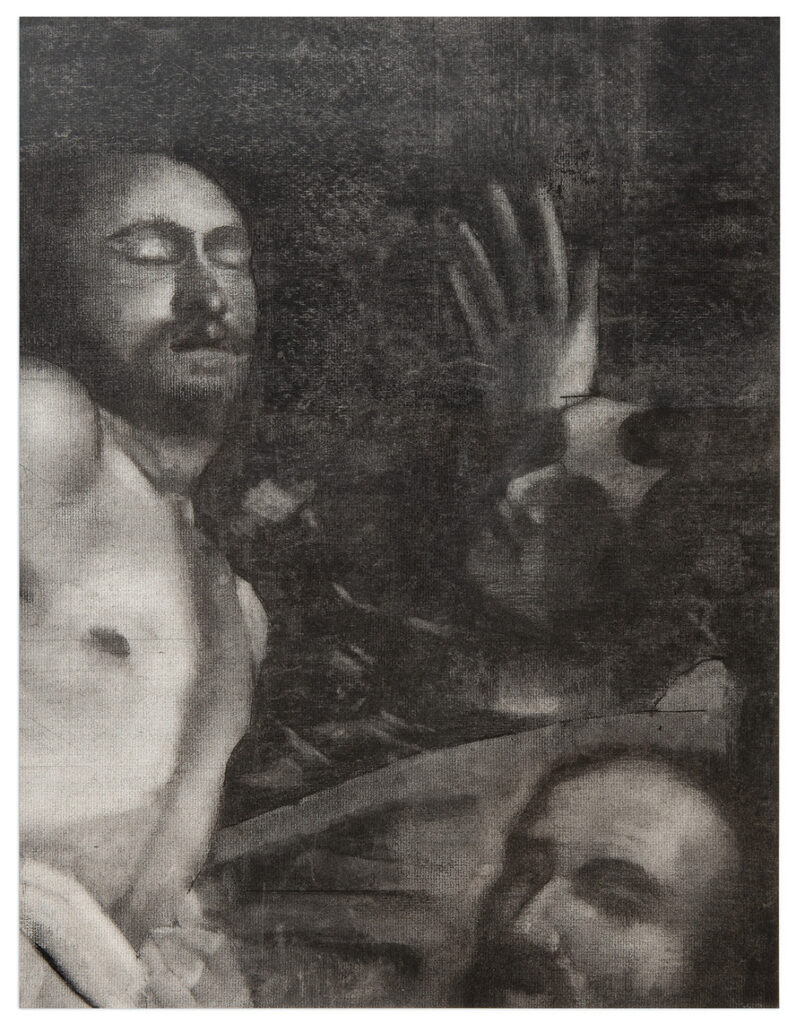
שרה נינה מרידור, אלפא, 2020 , פחם על נייר, 61×46
Sarah Nina Meridor, Alpha, 2020, Charcoal on paper, 61×46
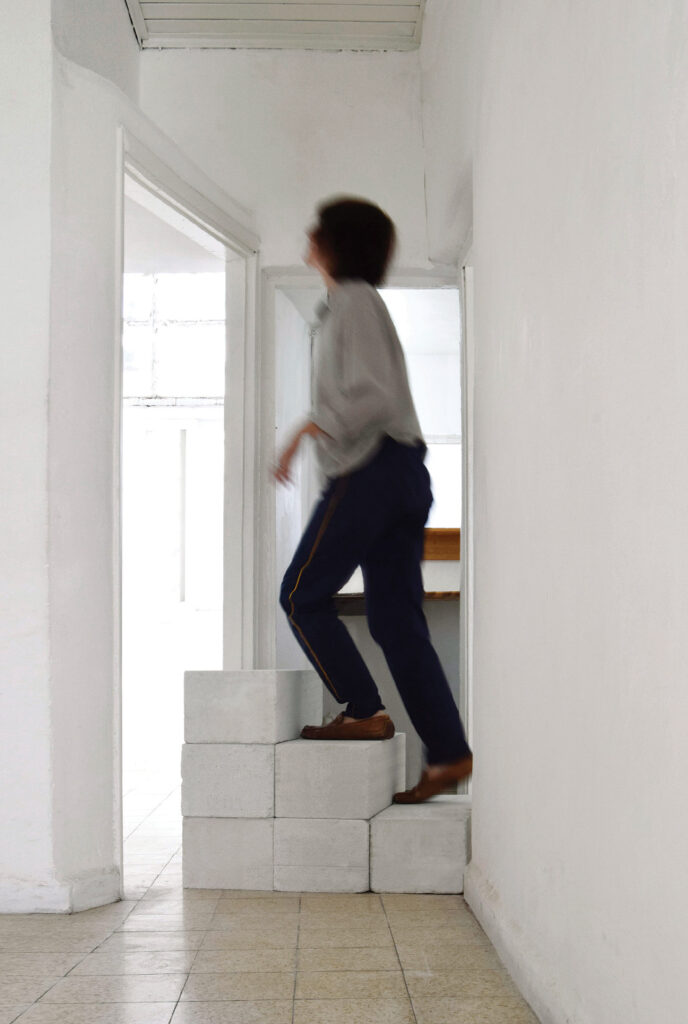
מירי גרמיזו, ללא כותרת, 2022 , טכניקה מעורבת: בלוקים, תצלום, 252x80x80
Miri Garmizo, Untitled, 2022, Mixed technique: blocks, photograph, 252x80x80
